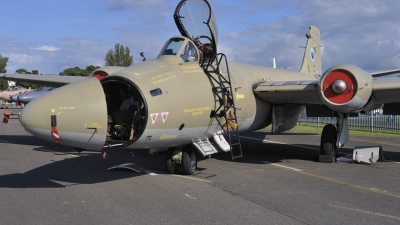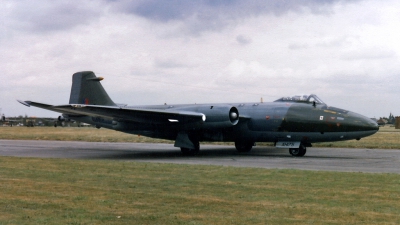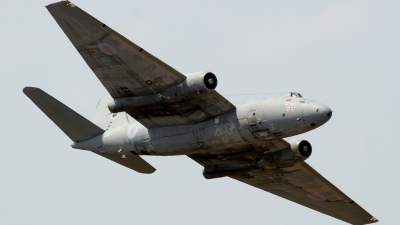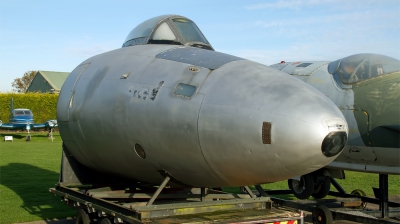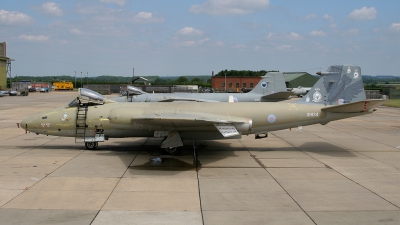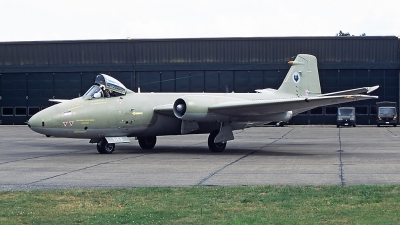English Electric Canberra PR9 Aircraft Data
The Canberra PR.9 was the ultimate photographic reconnaissance version of the highly successful Canberra family.
The operational ceiling of 50,000 feet (15,250 metres) of the PR.9's predeccessors was impressive, but as these entered service with the RAF thought was being given to developing a Canberra that no adversary interceptor would be able to reach. The new Avon RA.24 engine, which could provide 67,6 kN (5,110 kgp / 15,200 lbf) thrust, 50% more than the Avon 109 in the PR.7 and a new wing design, with extended chord inboard of the engines and a span stretch of 3 feet 10 inches (1.15 metres) would enable the PR.9 to operate over 60,000 feet.
In April 1954, Canberra PR.7 WH793 had just been completed at Samlesbury and was awaiting collection by the 23rd of that month. Instead of entering RAF-service the aircraft was delivered to D. Napier and Sons Ltd. for the fitting of the new wing design. The aircraft retained the 'bomber canopy' of the PR.7. WH793 made her first flight as PR.9 prototype on 8 May 1955 in the hands of Napier's test pilot Mike Randrup.
In the course of the flight testing of WH793 it became clear, that although the climb rate was significantly higher than that of the earlier PR-versions, the service-ceiling fell short of the expected 65,000 ft plus, due to unexpected drag rise at high altitude. The benefits of the more powerful engines and wing however were substantial enough to approve production of the high-altitude PR Canberra, the PR.9.
On 10 April 1958, the former Canberra B.5 prototype, VX185, was delivered to Shorts for PR.9 development work. The 'prototype PR9' and first production aircraft, XH129, first flew from Aldergrove on 27 July 1958. Unlike WH793 it featured a redesigned forward fuselage, with an offset cockpit with a canopy similar in appearance to that of the B(I).8. The two crew, pilot and navigator, were seated in separate pressurized compartments. The navigator accessed his compartment through the nose, which hinged open to the right. At the time of the first flight, only the pilot's position had an ejection seat. The nose section in these early PR.9s, and so XH129, being similar to the B(I).8, lacked an ejector seat for the navigator. It also featured a glazed front section as on the PR.3 and PR.7.
XH129 was delivered to English Electric at Samlesbury for type handling and flight testing on 11 September 1958. On one of these flights, on 9 October 1958, the aircraft was scheduled to carry out some 5g turns. During one of these tirns, XH129 entered an uncontrollable roll to starboard followed by a spiral dive due to failure of the leading edge wing root skin attachments. Shortly before crashing into Liverpool Bay off the Lancashire coast, Don Knight, the pilot ejected. Tragically, the English Electric Flight Test Officer occupied, Peter H. Durrant, was unable to leave the aircraft in time. As a consequence all subsequent aircraft were fitted with an ejection seat for the navigator.
Canberra PR.9 in RAF service
The Canberra PR.9 entered squadron service with No.58 Squadron at RAF Wyton in January 1960. On 22 June 2006, the last operational Camberra PR.9s of No.39 (1PRU) Squadron were retired at RAF Marham, after 55 years of Canberra service with the RAF.
Canberra PR.9 production
All 23 aircraft were produced by Short Bros.&Harland Ltd in Belfast. The first aircraft, XH129, first flew on 27 July 1958 from Sydenham in the hands of English Electric's chief test pilot Peter Hillwood. On 9 October 1958, this aircraft crashed into the Irish Sea. Pilot Don Knight survived the accident, but his flight test observer Peter Durrant was killed.
XH129-137 (c/n SH.1719 to SH.1727).
XH164-177 (c/n SH.1728 to SH.1741).
Of these aircraft, XH132 was modified by Shorts under a Ministry of Supply contract. The aircraft was given the designation SC.9. XH132 was employed in trials of the De Havilland Red Top air-to-air missile. For these the aircraft was fitted with the Ferranti A.I.23 Airpass radar of the Lightning. Later the aircraft was used by Ferranti as a radar trials aircraft, before continuing her work with the Radar Research Establishment at Pershore where she was engaged in the evaluation of the seeker system for the Skyflash air-to-air missile (AAM).
Notes on Canberra construction numbers:
Almost all construction numbers of English Electric Preston-built machines are known and confirmed. All Canberra PR.3 and 7 construction numbers are prefixed 'EEP' followed by a 5-digit number in the 71... range. The PR machines were produced along the B.2 at the production line and had their construction number allocated in order as the aircraft appeared on the line. This was also the case at the time the PR.7 came into production. As the final PR version, the Canberra PR.9, was solely produced by Short Bros & Harland, the construction numbers of these were allocated in sequence, prefixed 'SH'.
The operational ceiling of 50,000 feet (15,250 metres) of the PR.9's predeccessors was impressive, but as these entered service with the RAF thought was being given to developing a Canberra that no adversary interceptor would be able to reach. The new Avon RA.24 engine, which could provide 67,6 kN (5,110 kgp / 15,200 lbf) thrust, 50% more than the Avon 109 in the PR.7 and a new wing design, with extended chord inboard of the engines and a span stretch of 3 feet 10 inches (1.15 metres) would enable the PR.9 to operate over 60,000 feet.
In April 1954, Canberra PR.7 WH793 had just been completed at Samlesbury and was awaiting collection by the 23rd of that month. Instead of entering RAF-service the aircraft was delivered to D. Napier and Sons Ltd. for the fitting of the new wing design. The aircraft retained the 'bomber canopy' of the PR.7. WH793 made her first flight as PR.9 prototype on 8 May 1955 in the hands of Napier's test pilot Mike Randrup.
In the course of the flight testing of WH793 it became clear, that although the climb rate was significantly higher than that of the earlier PR-versions, the service-ceiling fell short of the expected 65,000 ft plus, due to unexpected drag rise at high altitude. The benefits of the more powerful engines and wing however were substantial enough to approve production of the high-altitude PR Canberra, the PR.9.
On 10 April 1958, the former Canberra B.5 prototype, VX185, was delivered to Shorts for PR.9 development work. The 'prototype PR9' and first production aircraft, XH129, first flew from Aldergrove on 27 July 1958. Unlike WH793 it featured a redesigned forward fuselage, with an offset cockpit with a canopy similar in appearance to that of the B(I).8. The two crew, pilot and navigator, were seated in separate pressurized compartments. The navigator accessed his compartment through the nose, which hinged open to the right. At the time of the first flight, only the pilot's position had an ejection seat. The nose section in these early PR.9s, and so XH129, being similar to the B(I).8, lacked an ejector seat for the navigator. It also featured a glazed front section as on the PR.3 and PR.7.
XH129 was delivered to English Electric at Samlesbury for type handling and flight testing on 11 September 1958. On one of these flights, on 9 October 1958, the aircraft was scheduled to carry out some 5g turns. During one of these tirns, XH129 entered an uncontrollable roll to starboard followed by a spiral dive due to failure of the leading edge wing root skin attachments. Shortly before crashing into Liverpool Bay off the Lancashire coast, Don Knight, the pilot ejected. Tragically, the English Electric Flight Test Officer occupied, Peter H. Durrant, was unable to leave the aircraft in time. As a consequence all subsequent aircraft were fitted with an ejection seat for the navigator.
Canberra PR.9 in RAF service
The Canberra PR.9 entered squadron service with No.58 Squadron at RAF Wyton in January 1960. On 22 June 2006, the last operational Camberra PR.9s of No.39 (1PRU) Squadron were retired at RAF Marham, after 55 years of Canberra service with the RAF.
Canberra PR.9 production
All 23 aircraft were produced by Short Bros.&Harland Ltd in Belfast. The first aircraft, XH129, first flew on 27 July 1958 from Sydenham in the hands of English Electric's chief test pilot Peter Hillwood. On 9 October 1958, this aircraft crashed into the Irish Sea. Pilot Don Knight survived the accident, but his flight test observer Peter Durrant was killed.
XH129-137 (c/n SH.1719 to SH.1727).
XH164-177 (c/n SH.1728 to SH.1741).
Of these aircraft, XH132 was modified by Shorts under a Ministry of Supply contract. The aircraft was given the designation SC.9. XH132 was employed in trials of the De Havilland Red Top air-to-air missile. For these the aircraft was fitted with the Ferranti A.I.23 Airpass radar of the Lightning. Later the aircraft was used by Ferranti as a radar trials aircraft, before continuing her work with the Radar Research Establishment at Pershore where she was engaged in the evaluation of the seeker system for the Skyflash air-to-air missile (AAM).
Notes on Canberra construction numbers:
Almost all construction numbers of English Electric Preston-built machines are known and confirmed. All Canberra PR.3 and 7 construction numbers are prefixed 'EEP' followed by a 5-digit number in the 71... range. The PR machines were produced along the B.2 at the production line and had their construction number allocated in order as the aircraft appeared on the line. This was also the case at the time the PR.7 came into production. As the final PR version, the Canberra PR.9, was solely produced by Short Bros & Harland, the construction numbers of these were allocated in sequence, prefixed 'SH'.
- Country of Origin: United Kingdom
- First Flight: 27 July 1958
- Initial Service Date: January 1960
- No. Built: 23
- No. In Service: 0
- No. of Hardpoints: 0
- Crew: 2
Power:
Two Rolls Royce RA.24 Avon Mk.206 at 15,200 lbf
Weapons:
The Canberra PR.9 was unarmed but carried an array of photographic reconnaissance equipment and sensors.
PR.9 camera systems
The Canberra PR.9 was unarmed but carried an array of photographic reconnaissance equipment and sensors. Since the introduction of the PR.9, its electronic and optical systems were modified and adapted regurarly to to keep them up to date with developments in photo reconnaissance. From 1976 twelve of the remaining 16 PR.9s were upgraded and optimised for low-level tactical reconnaissance, including the installation of a Decca Tactical Air Navigation System (TANS) to improve track keeping capability, an upgraded Doppler and a new Sperry Master Reference Gyro.
Under the navigator's compartment an aperture was provided for a F95 Mk.7 camera with a 4 or 12inch focal length lens. The negative size was 2½x2½inch. The magazine contained film for up to 500 exposures. The F95 could take up to 12 frames per second. On both sides of the navigator's compartment, the two other oblique F95s were placed, just behind the level of the ejection seat. These were operated by the pilot, but were selected and switched on or off by the navigator. Although the F95 and F96 cameras with their wet film were rendered outdated in the digital age, they remained standard equipment on the PR.9.
In the early days the PR.9 made use of F52 cameras, but these were replaced by the F96. Focal lengths up to 48". The F96 with 9x9inch large format film remained in use for a long time for general vertical photography.
The Recon Optical KA-93 panoramic camera, installed in the forward bay, replaced the F96. The KA-93 with a wide-angle 24inch lens provided high-resolution coverage from the horizon to the vertical either side of the flight path. This imagery supplemented the narrow-angle images at long slant range produced by the RADEOS (Rapid Deployable Electro-Optical System).
Survey photography
Initially the PR.9 carried the gyrostabilized F49 Mk.4 survey camera fitted in a pod in flare bay. This camera system was later replaced by a Zeiss RMK-A camera. Lenses with a focal length of 6 or 12inch could be fitted.
Night photography
Fitted to the photographic reconnaissance variants of the Canberra, the F97 Mk II camera was designed for use at low level at night. It was manufactured by Analytical Graphics International PLC and fitted to the Canberra PR.3, PR.7 and PR.9 between the 1950s and the 1970s. The camera was designed for use at low level (between 500 and 3,000 ft) at night and at speeds between 300 and 600 kt. The camera had two 5inch lenses which operated alternately to produce overlapping aerial photographs. The negative size was 5 by 4½inch. The illumination needed was provided by 256 1.75inch photo-flash cartridges (flares) with two-second fuses, which were automatically released from a cartridge dispenser when the camera was activated. The photo-flash crate was installed in the flare bay firing the flares downwards and slightly backwards.
The other camera system for high level night photopgraphy was the F89 (negative size: 7½x8½inch) with 20 or 36inch lenses.
From 1975 the F97 was replaced by the ARI 5969/2 Infra Red Line Scan (IRLS), taken from redundant Phantom reconnaissance pods. The IRLS was installed in the Canberra's flare bay.
The introduction of the System IIIb camera could take photographs from vertical as well as obliquely so as to produce sharp overlap images. The System IIIb was also housed in the flare bay. The System IIIb was derived from a similar system used in the USAF's Lockheed U-2R and U-2S aircraft. Both systems were eventually replaced in 1997 by the RADEOS (Rapid Deployable Electro-Optical System), which was also in use in the U-2R and S models. With the arrival of GPS technology, linked to the TANS (Tactical Air Navigation System) a very high level of accuracy with the RADEOS could be achieved. The RADEOS is sometimes referred to as the Electro-Optical Long Range Photography (EO-LOROP).
A later development saw the ability of the RADEOS to interface with the USAF's 'Senior Year Electro-Optical Relay' (SYERS). For the first time the PR.9s imagery could be relayed to ground stations for immediate interpretation.
The Recon Optical KA-93 panoramic camera, installed in the forward bay, replaced the F96. The system was fitted in the remaining PR.9s in 1997. The KA-93 with a wide-angle 24inch lens provided high-resolution coverage on 5inch film from the horizon to the vertical either side of the flight path. This imagery supplemented the narrow-angle images at long slant range produced by the RADEOS.
PR.9 defensive systems
The Canberra PR.9 has seen all corners of the globe, be it on survey and mapping flights on behalf of the British or foreign governments or on military assignments over potential hotspots. For the purpose of self protection, in 1982 the PR.9s had been fitted with radar warning receivers taken from retired Vulcan bombers. The AN/ARI 18228/6 receivers were fitted to the fin leading edge and in the tailcone. These were later replaced by the ARI 18228/19 or 20 systems.
Before the installation of the new Defensive Aid Suite (DAS), Canberras were fitted with underwing BOZ-107 chaff and flare dispenser pods as a temporary protective measure as seen in the photograpgh of XH169 at Aviano on 3 May 1998 (Photo ID.161534). The BOZ-107 was subsequently replaced by the Thales Vinten 78 Series 455 system installed in the starboard wing root.
PR.9 camera systems
The Canberra PR.9 was unarmed but carried an array of photographic reconnaissance equipment and sensors. Since the introduction of the PR.9, its electronic and optical systems were modified and adapted regurarly to to keep them up to date with developments in photo reconnaissance. From 1976 twelve of the remaining 16 PR.9s were upgraded and optimised for low-level tactical reconnaissance, including the installation of a Decca Tactical Air Navigation System (TANS) to improve track keeping capability, an upgraded Doppler and a new Sperry Master Reference Gyro.
Under the navigator's compartment an aperture was provided for a F95 Mk.7 camera with a 4 or 12inch focal length lens. The negative size was 2½x2½inch. The magazine contained film for up to 500 exposures. The F95 could take up to 12 frames per second. On both sides of the navigator's compartment, the two other oblique F95s were placed, just behind the level of the ejection seat. These were operated by the pilot, but were selected and switched on or off by the navigator. Although the F95 and F96 cameras with their wet film were rendered outdated in the digital age, they remained standard equipment on the PR.9.
In the early days the PR.9 made use of F52 cameras, but these were replaced by the F96. Focal lengths up to 48". The F96 with 9x9inch large format film remained in use for a long time for general vertical photography.
The Recon Optical KA-93 panoramic camera, installed in the forward bay, replaced the F96. The KA-93 with a wide-angle 24inch lens provided high-resolution coverage from the horizon to the vertical either side of the flight path. This imagery supplemented the narrow-angle images at long slant range produced by the RADEOS (Rapid Deployable Electro-Optical System).
Survey photography
Initially the PR.9 carried the gyrostabilized F49 Mk.4 survey camera fitted in a pod in flare bay. This camera system was later replaced by a Zeiss RMK-A camera. Lenses with a focal length of 6 or 12inch could be fitted.
Night photography
Fitted to the photographic reconnaissance variants of the Canberra, the F97 Mk II camera was designed for use at low level at night. It was manufactured by Analytical Graphics International PLC and fitted to the Canberra PR.3, PR.7 and PR.9 between the 1950s and the 1970s. The camera was designed for use at low level (between 500 and 3,000 ft) at night and at speeds between 300 and 600 kt. The camera had two 5inch lenses which operated alternately to produce overlapping aerial photographs. The negative size was 5 by 4½inch. The illumination needed was provided by 256 1.75inch photo-flash cartridges (flares) with two-second fuses, which were automatically released from a cartridge dispenser when the camera was activated. The photo-flash crate was installed in the flare bay firing the flares downwards and slightly backwards.
The other camera system for high level night photopgraphy was the F89 (negative size: 7½x8½inch) with 20 or 36inch lenses.
From 1975 the F97 was replaced by the ARI 5969/2 Infra Red Line Scan (IRLS), taken from redundant Phantom reconnaissance pods. The IRLS was installed in the Canberra's flare bay.
The introduction of the System IIIb camera could take photographs from vertical as well as obliquely so as to produce sharp overlap images. The System IIIb was also housed in the flare bay. The System IIIb was derived from a similar system used in the USAF's Lockheed U-2R and U-2S aircraft. Both systems were eventually replaced in 1997 by the RADEOS (Rapid Deployable Electro-Optical System), which was also in use in the U-2R and S models. With the arrival of GPS technology, linked to the TANS (Tactical Air Navigation System) a very high level of accuracy with the RADEOS could be achieved. The RADEOS is sometimes referred to as the Electro-Optical Long Range Photography (EO-LOROP).
A later development saw the ability of the RADEOS to interface with the USAF's 'Senior Year Electro-Optical Relay' (SYERS). For the first time the PR.9s imagery could be relayed to ground stations for immediate interpretation.
The Recon Optical KA-93 panoramic camera, installed in the forward bay, replaced the F96. The system was fitted in the remaining PR.9s in 1997. The KA-93 with a wide-angle 24inch lens provided high-resolution coverage on 5inch film from the horizon to the vertical either side of the flight path. This imagery supplemented the narrow-angle images at long slant range produced by the RADEOS.
PR.9 defensive systems
The Canberra PR.9 has seen all corners of the globe, be it on survey and mapping flights on behalf of the British or foreign governments or on military assignments over potential hotspots. For the purpose of self protection, in 1982 the PR.9s had been fitted with radar warning receivers taken from retired Vulcan bombers. The AN/ARI 18228/6 receivers were fitted to the fin leading edge and in the tailcone. These were later replaced by the ARI 18228/19 or 20 systems.
Before the installation of the new Defensive Aid Suite (DAS), Canberras were fitted with underwing BOZ-107 chaff and flare dispenser pods as a temporary protective measure as seen in the photograpgh of XH169 at Aviano on 3 May 1998 (Photo ID.161534). The BOZ-107 was subsequently replaced by the Thales Vinten 78 Series 455 system installed in the starboard wing root.
Dimensions:
| Length: | 66 ft 8 in. |
| Wing Span: | 69 ft 5 in. |
| Wing Area: | 1,045 sq.ft |
| Height: | 15 ft 7 in. |
| Max. Weight: | 57,500 lbs |
Performance:
| Max. Speed: | 560 mph |
| Service Ceiling: | 60,000 ft. |
| Max. Range: | 3,477 nm |
Operators:
ChileThe Chilean Air Force obtained three former RAF PR.9s:
XH166 (c/n SH.1730) to Chile on 15 October 1982 as '341'.
XH167 (c/n SH.1731) to Chile on 15 October 1982 as '342'.
XH173 (c/n SH.1737) to Chile on 15 October 1982 as '343'.
United Kingdom
Canberra PR.9 units were:
No.13 Squadron, RAF Luqa, Malta (from August 1961 to November 1978)
No.39 Squadron at RAF Luqa (from November 1962 to October 1970) an operating from RAF Wyton from October 1970 to May 1982).
No.39(1PRU) Squadron, RAF Marham (from April 1993 to July 2006).
No.58 Squadron, RAF Wyton (from January 1960 to March 1963).
No.1 Photographic Reconnaissance Unit, RAF Wyton (from June 1982 to April 1993.
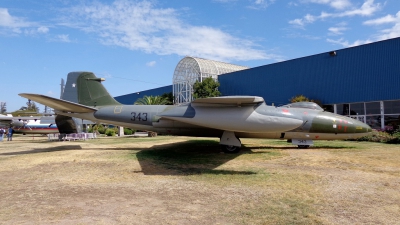
 Random great photos of the English Electric Canberra PR9:
Random great photos of the English Electric Canberra PR9:
